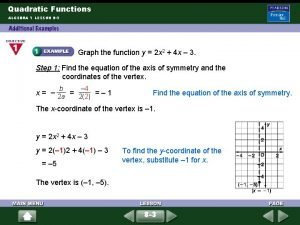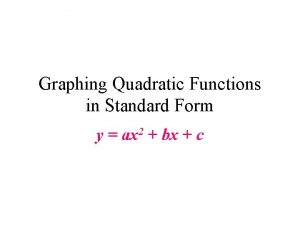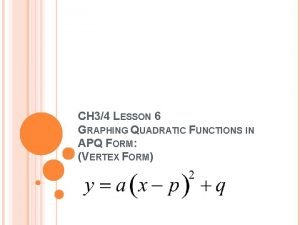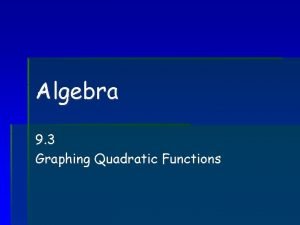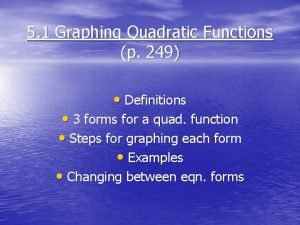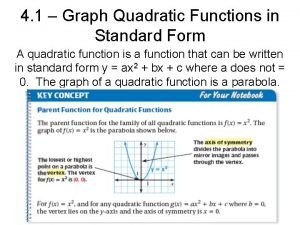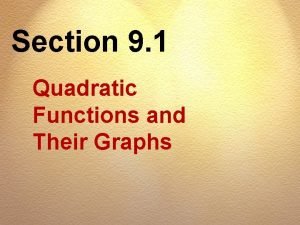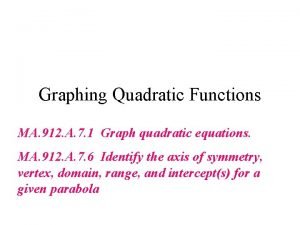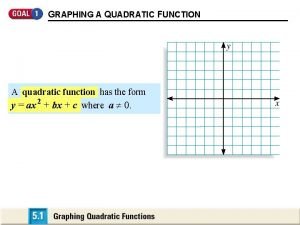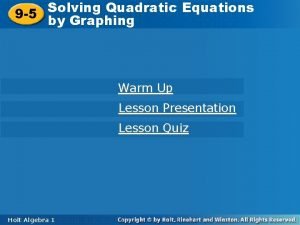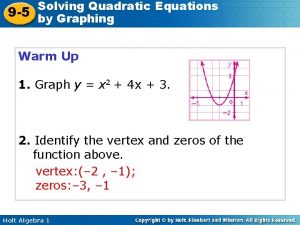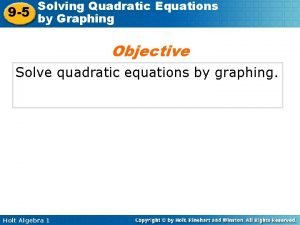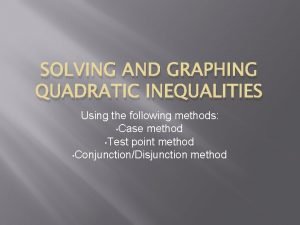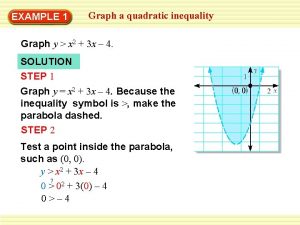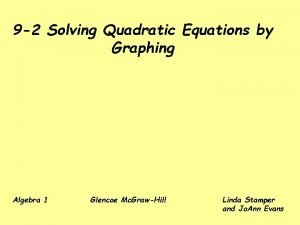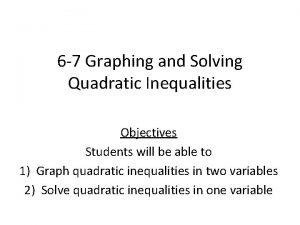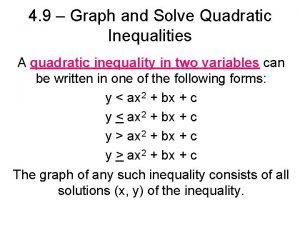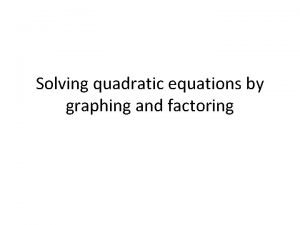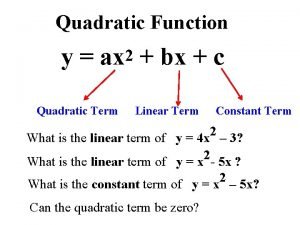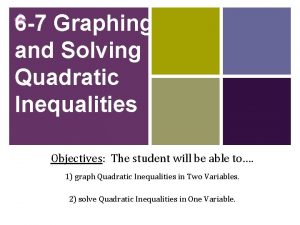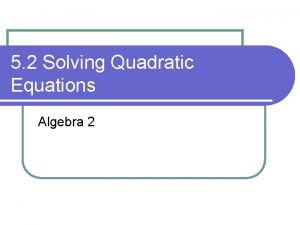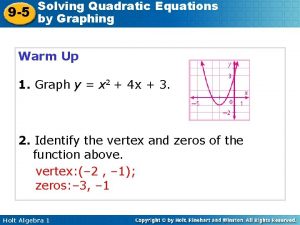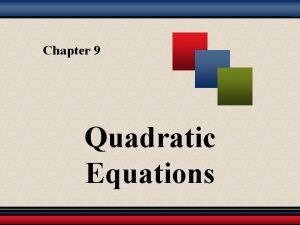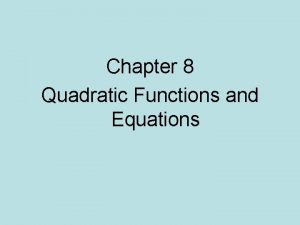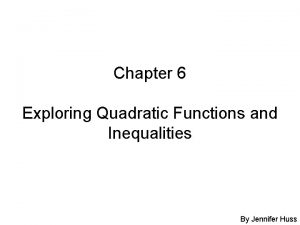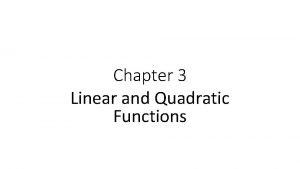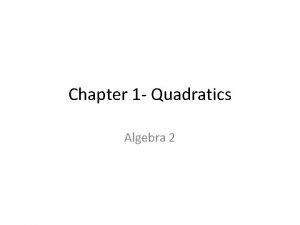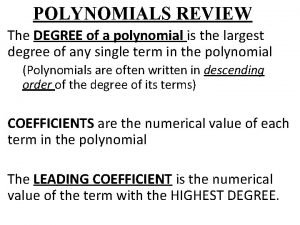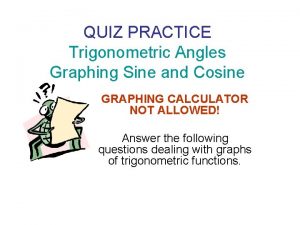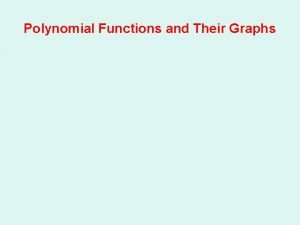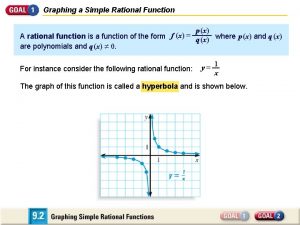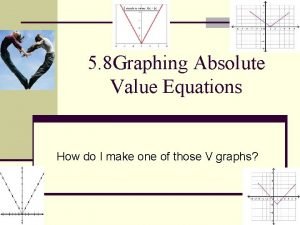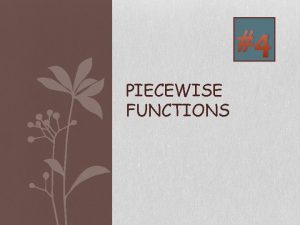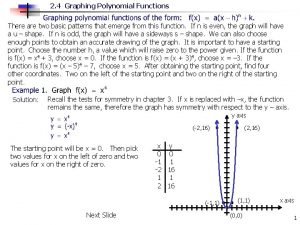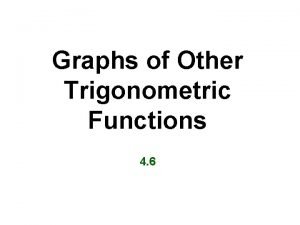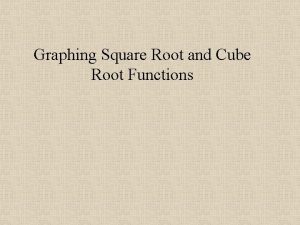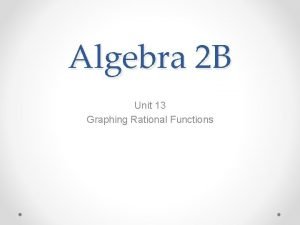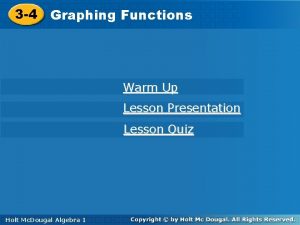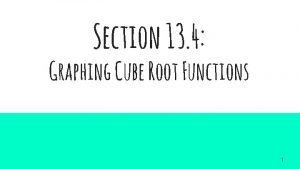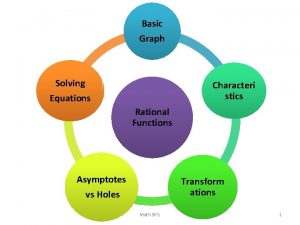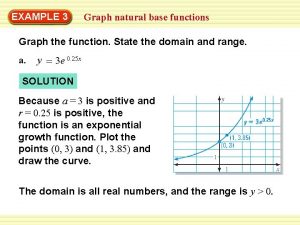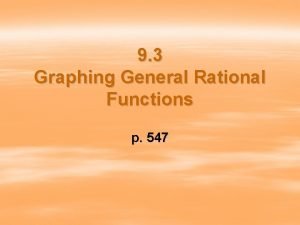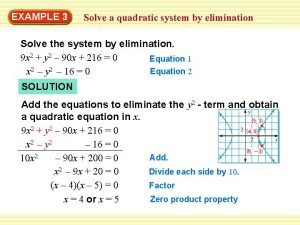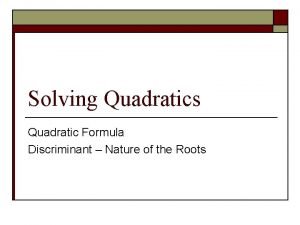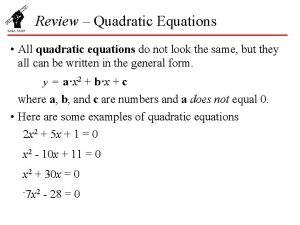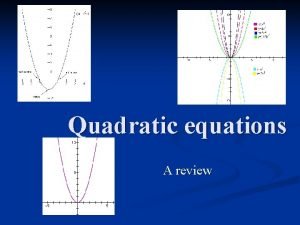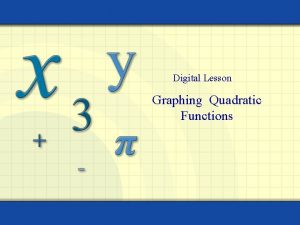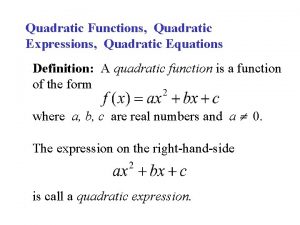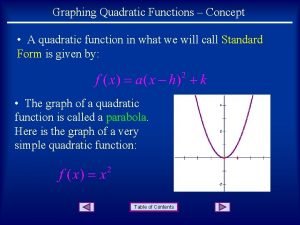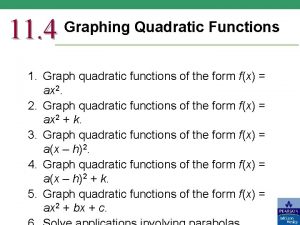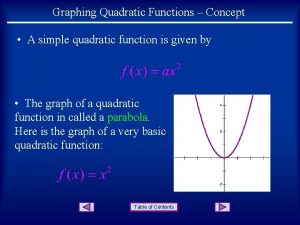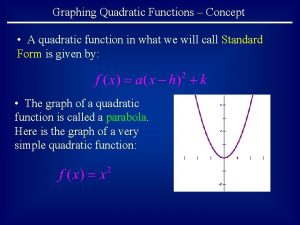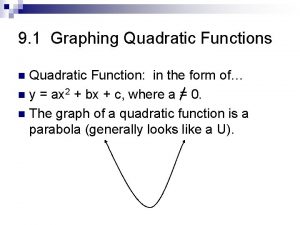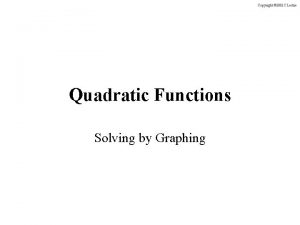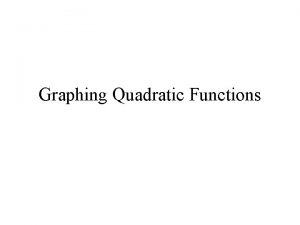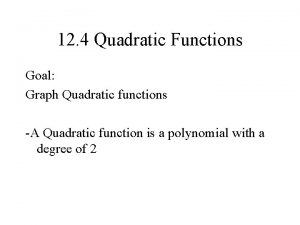Chapter 8 Review Quadratic Functions 8 3 Graphing


















































































- Slides: 82

Chapter 8 Review Quadratic Functions

§ 8. 3 Graphing Quadratic Equations in Two Variables

Graphs of Quadratic Equations We spent a lot of time graphing linear equations in chapter 3. The graph of a quadratic equation is a parabola. The highest point or lowest point on the parabola is the vertex. Axis of symmetry is the line that runs through the vertex and through the middle of the parabola. Martin-Gay, Developmental Mathematics 3

Graphs of Quadratic Equations Example y Graph y = 2 x 2 – 4. x y 2 1 0 – 1 – 2 4 – 2 – 4 – 2 4 (– 2, 4) (2, 4) x (– 1, – 2) (0, – 4) Martin-Gay, Developmental Mathematics 4

Intercepts of the Parabola Although we can simply plot points, it is helpful to know some information about the parabola we will be graphing prior to finding individual points. To find x-intercepts of the parabola, let y = 0 and solve for x. To find y-intercepts of the parabola, let x = 0 and solve for y. Martin-Gay, Developmental Mathematics 5

Characteristics of the Parabola If the quadratic equation is written in standard form, y = ax 2 + bx + c, 1) the parabola opens up when a > 0 and opens down when a < 0. 2) the x-coordinate of the vertex is . To find the corresponding y-coordinate, you substitute the x-coordinate into the equation and evaluate for y. Martin-Gay, Developmental Mathematics 6

Graphs of Quadratic Equations Example Graph y = – 2 x 2 + 4 x + 5. Since a = – 2 and b = 4, the graph opens down and the x-coordinate of the vertex is x y 3 – 1 2 5 1 7 0 5 – 1 y (0, 5) (– 1, – 1) Martin-Gay, Developmental Mathematics (1, 7) (2, 5) (3, – 1) x 7

The Graph of a Quadratic Function The vertical line which passes through the vertex is called the Axis of Symmetry or the Axis Recall that the equation of a vertical line is x =c For some constant c x coordinate of the vertex The y coordinate of the vertex is The Axis of Symmetry is the x = Martin-Gay, Developmental Mathematics 8

The Quadratic function t Opens up when a>o opens down a < 0 Vertex axis of symmetry Martin-Gay, Developmental Mathematics 9

Identify the Vertex and Axis of Symmetry of a Quadratic Function t Vertex =(x, y). thus t Vertex = t Axis of Symmetry: the line x = t Vertex is minimum point if parabola opens up t Vertex is maximum point if parabola opens down Martin-Gay, Developmental Mathematics 10

Identify the Vertex and Axis of Symmetry t Vertex x= = = -1 -3 y= t Vertex = (-1, -3) t Axis of Symmetry is x = = -1 Martin-Gay, Developmental Mathematics 11

8. 5 Quadratic Solutions The number of real solutions is at most two. No solutions One solution Two solutions Martin-Gay, Developmental Mathematics 12

Identifying Solutions 2 Example f(x) = x - 4 Solutions are -2 and 2. Martin-Gay, Developmental Mathematics 13

Identifying Solutions Now you try this problem. f(x) = 2 x - x 2 Solutions are 0 and 2. Martin-Gay, Developmental Mathematics 14

Graphing Quadratic Equations The graph of a quadratic equation is a parabola. The roots or zeros are the xintercepts. The vertex is the maximum or minimum point. All parabolas have an axis of symmetry. Martin-Gay, Developmental Mathematics 15

Graphing Quadratic Equations One method of graphing uses a table with arbitrary x-values. Graph y = x 2 - 4 x x y 0 1 2 3 4 0 -3 -4 -3 0 Roots 0 and 4 , Vertex (2, -4) , Axis of Symmetry x = 2 Martin-Gay, Developmental Mathematics 16

Graphing Quadratic Equations Try this problem y = x 2 - 2 x - 8. x y -2 -1 1 3 4 Roots Vertex Axis of Symmetry Martin-Gay, Developmental Mathematics 17

8. 6 – Solving Quadratic Equations by Factoring A quadratic equation is written in the Standard Form, where a, b, and c are real numbers and . Examples: (standard form) Martin-Gay, Developmental Mathematics 18

8. 6 – Solving Quadratic Equations by Factoring Zero Factor Property: If a and b are real numbers and if then or. , Examples: Martin-Gay, Developmental Mathematics 19

8. 6 – Solving Quadratic Equations by Factoring Zero Factor Property: If a and b are real numbers and if then or. , Examples: Martin-Gay, Developmental Mathematics 20

8. 6 – Solving Quadratic Equations by Factoring Solving Quadratic Equations: 1) Write the equation in standard form. 2) Factor the equation completely. 3) Set each factor equal to 0. 4) Solve each equation. 5) Check the solutions (in original equation). Martin-Gay, Developmental Mathematics 21

8. 6 – Solving Quadratic Equations by Factoring Martin-Gay, Developmental Mathematics 22

8. 6 – Solving Quadratic Equations by Factoring If the Zero Factor Property is not used, then the solutions will be incorrect Martin-Gay, Developmental Mathematics 23

8. 6 – Solving Quadratic Equations by Factoring Martin-Gay, Developmental Mathematics 24

8. 6 – Solving Quadratic Equations by Factoring Martin-Gay, Developmental Mathematics 25

8. 6 – Solving Quadratic Equations by Factoring Martin-Gay, Developmental Mathematics 26

8. 6 – Solving Quadratic Equations by Factoring Martin-Gay, Developmental Mathematics 27

8. 6 – Solving Quadratic Equations by Factoring Martin-Gay, Developmental Mathematics 28

8. 6 – Quadratic Equations and Problem Solving A cliff diver is 64 feet above the surface of the water. The formula for calculating the height (h) of the diver after t seconds is: How long does it take for the diver to hit the surface of the water? seconds Martin-Gay, Developmental Mathematics 29

8. 6 – Quadratic Equations and Problem Solving The square of a number minus twice the number is 63. Find the number. x is the number. Martin-Gay, Developmental Mathematics 30

8. 6 – Quadratic Equations and Problem Solving The length of a rectangular garden is 5 feet more than its width. The area of the garden is 176 square feet. What are the length and the width of the garden? The width is w. The length is w+5. feet Martin-Gay, Developmental Mathematics 31

8. 6 – Quadratic Equations and Problem Solving Find two consecutive odd numbers whose product is 23 more than their sum? Consecutive odd numbers: Martin-Gay, Developmental Mathematics 32

8. 6 – Quadratic Equations and Problem Solving The length of one leg of a right triangle is 7 meters less than the length of the other leg. The length of the hypotenuse is 13 meters. What are the lengths of the legs? meters Martin-Gay, Developmental Mathematics 33

§ 8. 7 Solving Quadratic Equations by the Square Root Property

Square Root Property We previously have used factoring to solve quadratic equations. This chapter will introduce additional methods for solving quadratic equations. Square Root Property If b is a real number and a 2 = b, then Martin-Gay, Developmental Mathematics 35

Square Root Property Example Solve x 2 = 49 Solve 2 x 2 = 4 x 2 = 2 Solve (y – 3)2 = 4 y=3 2 y = 1 or 5 Martin-Gay, Developmental Mathematics 36

Square Root Property Example Solve x 2 + 4 = 0 x 2 = 4 There is no real solution because the square root of 4 is not a real number. Martin-Gay, Developmental Mathematics 37

Square Root Property Example Solve (x + 2)2 = 25 x = 2 ± 5 x = 2 + 5 or x = 2 – 5 x = 3 or x = 7 Martin-Gay, Developmental Mathematics 38

Square Root Property Example Solve (3 x – 17)2 = 28 3 x – 17 = Martin-Gay, Developmental Mathematics 39

§ 8. 8 Solving Quadratic Equations by Completing the Square

Completing the Square In all four of the previous examples, the constant in the square on the right side, is half the coefficient of the x term on the left. Also, the constant on the left is the square of the constant on the right. So, to find the constant term of a perfect square trinomial, we need to take the square of half the coefficient of the x term in the trinomial (as long as the coefficient of the x 2 term is 1, as in our previous examples). Martin-Gay, Developmental Mathematics 41

Completing the Square Example What constant term should be added to the following expressions to create a perfect square trinomial? x 2 – 10 x add 52 = 25 x 2 + 16 x add 82 = 64 x 2 – 7 x add Martin-Gay, Developmental Mathematics 42

Completing the Square Example We now look at a method for solving quadratics that involves a technique called completing the square. It involves creating a trinomial that is a perfect square, setting the factored trinomial equal to a constant, then using the square root property from the previous section. Martin-Gay, Developmental Mathematics 43

Completing the Square Solving a Quadratic Equation by Completing a Square 1) 2) 3) 4) 5) If the coefficient of x 2 is NOT 1, divide both sides of the equation by the coefficient. Isolate all variable terms on one side of the equation. Complete the square (half the coefficient of the x term squared, added to both sides of the equation). Factor the resulting trinomial. Use the square root property. Martin-Gay, Developmental Mathematics 44

Solving Equations Example Solve by completing the square. y 2 + 6 y = 8 y 2 + 6 y + 9 = 8 + 9 (y + 3)2 = 1 y+3=± =± 1 y = 3 ± 1 y = 4 or 2 Martin-Gay, Developmental Mathematics 45

Solving Equations Example Solve by completing the square. y 2 + y – 7 = 0 y 2 + y = 7 y 2 + y + ¼ = 7 + ¼ (y + ½)2 = Martin-Gay, Developmental Mathematics 46

Solving Equations Example Solve by completing the square. 2 x 2 + 14 x – 1 = 0 2 x 2 + 14 x = 1 x 2 + 7 x = ½ x 2 + 7 x + (x + =½+ = )2 = Martin-Gay, Developmental Mathematics 47

§ 8. 9 Solving Quadratic Equations by the Quadratic Formula

The Quadratic Formula Another technique for solving quadratic equations is to use the quadratic formula. The formula is derived from completing the square of a general quadratic equation. Martin-Gay, Developmental Mathematics 49

The Quadratic Formula A quadratic equation written in standard form, ax 2 + bx + c = 0, has the solutions. Martin-Gay, Developmental Mathematics 50

The Quadratic Formula Example Solve 11 n 2 – 9 n = 1 by the quadratic formula. 11 n 2 – 9 n – 1 = 0, so a = 11, b = -9, c = -1 Martin-Gay, Developmental Mathematics 51

The Quadratic Formula Example Solve x 2 + x – = 0 by the quadratic formula. x 2 + 8 x – 20 = 0 (multiply both sides by 8) a = 1, b = 8, c = 20 Martin-Gay, Developmental Mathematics 52

The Quadratic Formula Example Solve x(x + 6) = 30 by the quadratic formula. x 2 + 6 x + 30 = 0 a = 1, b = 6, c = 30 So there is no real solution. Martin-Gay, Developmental Mathematics 53

The Discriminant The expression under the radical sign in the formula (b 2 – 4 ac) is called the discriminant. The discriminant will take on a value that is positive, 0, or negative. The value of the discriminant indicates two distinct real solutions, one real solution, or no real solutions, respectively. Martin-Gay, Developmental Mathematics 54

The Discriminant Example Use the discriminant to determine the number and type of solutions for the following equation. 5 – 4 x + 12 x 2 = 0 a = 12, b = – 4, and c = 5 b 2 – 4 ac = (– 4)2 – 4(12)(5) = 16 – 240 = – 224 There are no real solutions. Martin-Gay, Developmental Mathematics 55

Solving Quadratic Equations Steps in Solving Quadratic Equations 1) 2) 3) 4) If the equation is in the form (ax+b)2 = c, use the square root property to solve. If not solved in step 1, write the equation in standard form. Try to solve by factoring. If you haven’t solved it yet, use the quadratic formula. Martin-Gay, Developmental Mathematics 56

Solving Equations Example Solve 12 x = 4 x 2 + 4. 0 = 4 x 2 – 12 x + 4 0 = 4(x 2 – 3 x + 1) Let a = 1, b = -3, c = 1 Martin-Gay, Developmental Mathematics 57

Solving Equations Example Solve the following quadratic equation. Martin-Gay, Developmental Mathematics 58

The Quadratic Formula Solve for x by completing the square. Martin-Gay, Developmental Mathematics 59

Yes, you can remember this formula Pop goes the Weasel http: //www. youtube. com/watch? v=2 lb. ABbf. U 6 Zc&featu re=related Gilligan’s Island http: //www. youtube. com/watch? v=3 CWTt 9 QFio. Y&feat ure=related This one I can’t explain http: //www. youtube. com/watch? v=haq 6 kp. Wd. EMs&feat ure=related Martin-Gay, Developmental Mathematics 60

How does it work Equation: Martin-Gay, Developmental Mathematics 61

How does it work Equation: Martin-Gay, Developmental Mathematics 62

The Discriminant The number in the square root of the quadratic formula. Martin-Gay, Developmental Mathematics 63

The Discriminant can be negative, positive or zero If the Discriminant is positive, there are 2 real answers. If the square root is not a prefect square ( for example ), then there will be 2 irrational roots ( for example ). Martin-Gay, Developmental Mathematics 64

The Discriminant can be negative, positive or zero If the Discriminant is positive, there are 2 real answers. If the Discriminant is zero, there is 1 real answer. If the Discriminant is negative, there are 2 complex answers. complex answer have i. Martin-Gay, Developmental Mathematics 65

Solve using the Quadratic formula Martin-Gay, Developmental Mathematics 66

Solve using the Quadratic formula Martin-Gay, Developmental Mathematics 67

Solve using the Quadratic formula Martin-Gay, Developmental Mathematics 68

Solve using the Quadratic formula Martin-Gay, Developmental Mathematics 69

Solve using the Quadratic formula Martin-Gay, Developmental Mathematics 70

Solve using the Quadratic formula Martin-Gay, Developmental Mathematics 71

Solve using the Quadratic formula Martin-Gay, Developmental Mathematics 72

Solve using the Quadratic formula Martin-Gay, Developmental Mathematics 73

Solve using the Quadratic formula Martin-Gay, Developmental Mathematics 74

Solve using the Quadratic formula Martin-Gay, Developmental Mathematics 75

Solve using the Quadratic formula Martin-Gay, Developmental Mathematics 76

Describe the roots Tell me the Discriminant and the type of roots Martin-Gay, Developmental Mathematics 77

Describe the roots Tell me the Discriminant and the type of roots 0, One rational root Martin-Gay, Developmental Mathematics 78

Describe the roots Tell me the Discriminant and the type of roots 0, One rational root Martin-Gay, Developmental Mathematics 79

Describe the roots Tell me the Discriminant and the type of roots 0, One rational root -11, Two complex roots Martin-Gay, Developmental Mathematics 80

Describe the roots Tell me the Discriminant and the type of roots 0, One rational root -11, Two complex roots Martin-Gay, Developmental Mathematics 81

Describe the roots Tell me the Discriminant and the type of roots 0, One rational root -11, Two complex roots 80, Two irrational roots Martin-Gay, Developmental Mathematics 82
 Lesson 8-1 transformations of functions
Lesson 8-1 transformations of functions Standard form y=ax^2+bx+c
Standard form y=ax^2+bx+c 9-1 practice graphing quadratic functions
9-1 practice graphing quadratic functions 9-3 graphing quadratic functions
9-3 graphing quadratic functions 9-1 graphing quadratic functions
9-1 graphing quadratic functions 4-1 graphing quadratic functions
4-1 graphing quadratic functions 9-3 graphing quadratic functions
9-3 graphing quadratic functions 9-1 graphing quadratic functions
9-1 graphing quadratic functions How to find vertex form from standard form
How to find vertex form from standard form 5-1 graphing quadratic functions
5-1 graphing quadratic functions Solving graphing and analyzing quadratic functions
Solving graphing and analyzing quadratic functions 4-1 graphing quadratic functions
4-1 graphing quadratic functions Graph quadratic functions in standard form
Graph quadratic functions in standard form 9-1 practice graphing quadratic functions
9-1 practice graphing quadratic functions Quadratic vocabulary
Quadratic vocabulary Graphing a quadratic function
Graphing a quadratic function Graph the quadratic function
Graph the quadratic function Chapter 3 graphing linear functions answer key
Chapter 3 graphing linear functions answer key 9-5 solving quadratic equations by graphing
9-5 solving quadratic equations by graphing 9-5 solving quadratic equations by graphing
9-5 solving quadratic equations by graphing 9-5 solving quadratic equations by graphing
9-5 solving quadratic equations by graphing Graphing quadratic inequalities
Graphing quadratic inequalities Graphing quadratic and linear systems
Graphing quadratic and linear systems Graphing quadratic inequalities
Graphing quadratic inequalities Quadratic inequality examples
Quadratic inequality examples 9-3 solving quadratic equations by graphing
9-3 solving quadratic equations by graphing Solving quadratic inequalities algebraically
Solving quadratic inequalities algebraically System of quadratic inequalities
System of quadratic inequalities How to find roots of equation
How to find roots of equation Y=ax2+c
Y=ax2+c Identifying quadratic functions
Identifying quadratic functions Quadratic inequalities shading
Quadratic inequalities shading 5-2 solving quadratic equations by graphing
5-2 solving quadratic equations by graphing 9-5 solving quadratic equations by graphing
9-5 solving quadratic equations by graphing Chapter 9 quadratic equations and functions
Chapter 9 quadratic equations and functions Chapter 8 quadratic functions and equations
Chapter 8 quadratic functions and equations Lesson 8 homework practice quadratic functions
Lesson 8 homework practice quadratic functions Chapter 6 quadratic functions and inequalities answers
Chapter 6 quadratic functions and inequalities answers Chapter 3 linear and quadratic functions
Chapter 3 linear and quadratic functions Chapter 1 quadratic functions and factoring
Chapter 1 quadratic functions and factoring Review graphing polynomials
Review graphing polynomials Graphing exponential functions assignment
Graphing exponential functions assignment Unit 5: polynomial functions homework 1
Unit 5: polynomial functions homework 1 12-7 graphing trigonometric functions answers
12-7 graphing trigonometric functions answers Graphing sine and cosine functions quiz
Graphing sine and cosine functions quiz Leading coefficient
Leading coefficient 4-5 practice graphing other trigonometric functions
4-5 practice graphing other trigonometric functions 4-4 graphing sine and cosine functions
4-4 graphing sine and cosine functions Graphing rational numbers
Graphing rational numbers Graphing irrational functions
Graphing irrational functions Absolute value graphing worksheet
Absolute value graphing worksheet Piecewise function examples
Piecewise function examples Polynomial function graph
Polynomial function graph Graphing other trig functions
Graphing other trig functions Cube root function graph
Cube root function graph Guided practice
Guided practice Exponential functions transformations
Exponential functions transformations Algebra 2b unit 3 exam
Algebra 2b unit 3 exam Graphing radical functions quiz part 2
Graphing radical functions quiz part 2 Lesson 3-4 graphing functions
Lesson 3-4 graphing functions Graphing cube root functions
Graphing cube root functions Graphing rational functions quiz
Graphing rational functions quiz Graphing rational functions
Graphing rational functions Graphing tangent with transformations
Graphing tangent with transformations Function and graph
Function and graph Graphing linear and exponential functions
Graphing linear and exponential functions Rational graph
Rational graph Graphing absolute value functions notes
Graphing absolute value functions notes Quiz 2-3 parent functions transformations graphing
Quiz 2-3 parent functions transformations graphing Radical functions and rational exponents
Radical functions and rational exponents Polynomial power function
Polynomial power function Lesson 5-2 graphing polynomial functions answers
Lesson 5-2 graphing polynomial functions answers Graphing natural base functions
Graphing natural base functions Asymptote examples
Asymptote examples How to find slant asymptotes
How to find slant asymptotes Chapter review motion part a vocabulary review answer key
Chapter review motion part a vocabulary review answer key Solving quadratic systems by elimination
Solving quadratic systems by elimination Quadratic formula nedir
Quadratic formula nedir Quadratic formula review
Quadratic formula review Quadratic function review
Quadratic function review Factoring quadratics review
Factoring quadratics review Vertex form example
Vertex form example Transformations of quadratic functions
Transformations of quadratic functions
